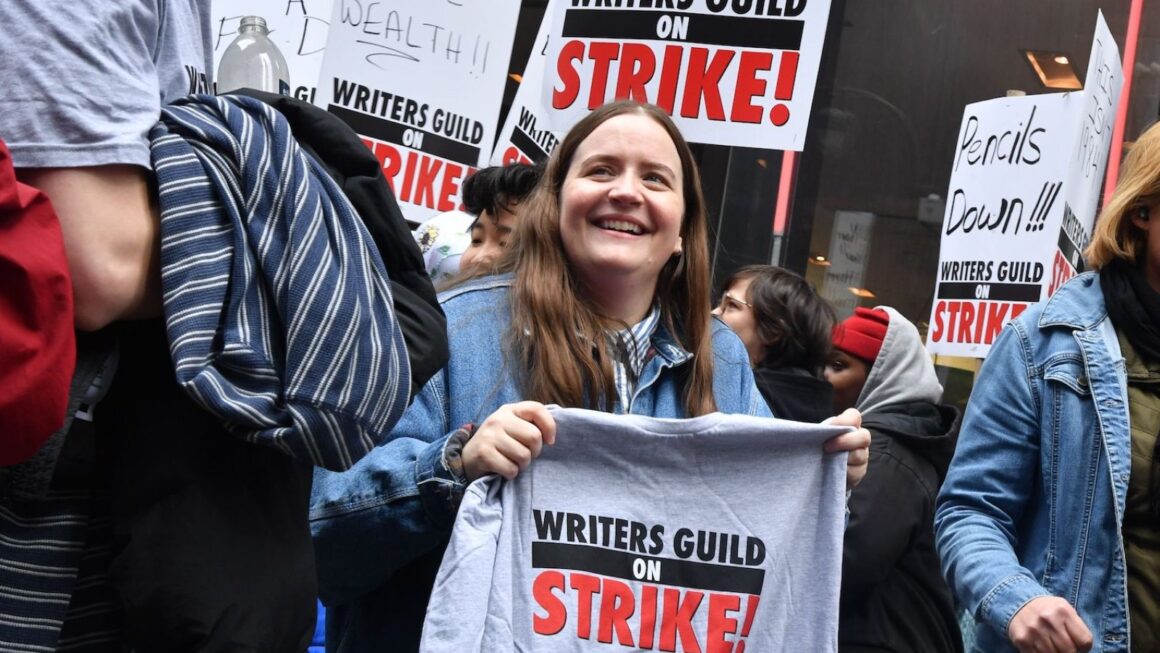By David Rhoades, Socialist Alternative (our sister organisation in the United States)
“Writers are an essential part of creating content that our audiences enjoy, really across all platforms,” said Paramount CEO Bob Bakish to investors while boasting about their 60 million streaming subscribers. At that same moment, the writers who’d helped generate millions in subscription revenue were picketing outside for their right to a living wage and secure employment.
On May 2, the Writers’ Guild of America — a union of about 11,500 film and TV writers — went on strike for the first time since 2007. Their opponent is the Alliance of Motion Picture & Television Producers, a trade association of about 350 firms led by a handful of major studios, including Disney, Netflix, Amazon, and Warner Bros.
The core issue of the strike is how streaming generated billions on the creative labor of the film and TV industry over the last decade. The top studios generated $28–30 billion a year in profits from 2017–2021. In 2000, those same studios produced $5 billion in profits; in 2022, Netflix generated $5.6 billion in profits by itself. Much of those profits are the result of exploiting loopholes in union contracts, paying writers less money for more output in increasingly precarious employment terms.
“The companies’ behavior has created a gig economy inside a union workforce,” the WGA negotiating committee said in a letter to its members.
How Streaming Turned Union Labor Into Gig Work
The 2023 WGA strike has been brought on by a decade of rapid changes to how movies and TV are produced. The popularity and critical acclaim of shows like Game of Thrones and Mad Men led to deeper investment in “prestige television.” Streaming platforms like Netflix and Amazon started producing their own movies and shows in-house while established studios like HBO and Disney built their own streaming services. Their plan was to attract subscribers by rapidly buying or producing as many film/TV projects as possible, capitalizing on the few properties that became hits. At first this seemed to create a plethora of writing jobs, but not for long.
Before the rise of streaming, TV shows were generally produced by writers’ rooms: a staff of 6–12 writers who were paid for 20–26 weeks per season on a three-year contract. Because streaming companies needed to generate new content quickly, they hired “mini-rooms” of 1–3 writers who would pitch ideas for an entire season of television in a few days, then rapidly draft a season’s worth of episodes in 5–10 weeks. Many of these pre-written seasons of TV have not been produced or were canceled before filming started; the few that entered production did so one or two years after the episodes were written.
In essence, streaming companies received an entire season of scripts and ideas for a fraction the cost of a fully staffed writers’ room, eliminating jobs while leaving writers with less pay and shorter-term employment.
Mini-rooms became industry standard as streaming shows became the only option for many writers. Prospects for writing feature films also turned bleak: because many films are now produced for direct-to-streaming release, studios get away with paying screenwriters the “movie of the week” rate instead of a much-higher theatrical film rate, despite many of these films possessing theatrical-level budgets. “What was once a difficult-to-get but well-paying job has become an impossible-to-get job that pays very little,” said Kit Brogden, a strike supporter who represents individual writers in employment negotiations who spoke to Socialist Alternative.
WGA Calls For An End To Mini-Room Exploitation
The central demand from the WGA is simple: no more mini-rooms.
For shows in pre-production, studios need to hire at least 6 writers for 10 weeks minimum. Most streaming shows in production would hire a staff of 6–12 writers for 24–52 weeks per season, depending on the number of episodes. Streaming movies with a budget over $12 million would need to pay full theatrical terms to screenwriters. The WGA has also demanded strict limitations on the use of AI programs like Chat GPT for writing, an increasingly real threat to entertainment writers today.
Though it’s not possible for the studios to use AI programs to generate all their content in an immediate sense, it’s a threat they dangle over the heads of workers in the WGA – accept what we’re willing to give you, or face being replaced. Though AI programs aren’t currently capable of writing coherent long-form stories on their own, the WGA is right to look ahead at this problem: any introduction of AI into the writing process would be akin to the two-tiered hiring faced by the logistics union; a huge concession to the bosses.
The AMPTP outright rejected most of these demands with no counter proposal. If they conceded a strong deal to the WGA now, the AMPTP knows it would be weaker in its upcoming negotiations with the directors’ union (DGA) and the performers’ union (SAG-AFTRA). In short, the studios aren’t withholding better pay because they don’t have the means, but because they know one concession would embolden other workers to fight for more as well.
“It’s the same story every time,” Melody Cooper, a striking writer/producer, said to Socialist Alternative. “Studios tell us ‘You’ll ruin the industry, we can’t pay you more.’ They said that in 1960, 1988, and 2007.” Meanwhile, just eight Hollywood CEOs made $800 million collectively last year. Melody pointed out that the studios have relied on writers’ desperation for years: “They know writers who are paid less are less likely to fight back.”
But the context of this strike is a remarkably different period of capitalism than previous WGA strikes. Adjusted for inflation, writers’ wages have fallen 23% over the last 10 years while CEO compensation has skyrocketed. Housing costs are inflating rapidly, particularly in Los Angeles where many writers live. Despite massive profits, the logic of capitalism demands streaming platforms achieve nigh-impossible subscriber growth to meet shareholder expectations, especially with a global economic crisis on the horizon.
In other words, despite making enormous profits, these companies are potentially less likely to grant concessions than in earlier strikes. In order to win these demands, the WGA may need to disrupt production at a broader scale than ever before.
What’s needed to force AMPTP to the table
Even after scripts are finalized, writers are vital to production. On-set input from writers is crucial to producing a coherent story with the collective labor of hundreds of artists, craftspeople, and technicians. However, that doesn’t stop studios from pressing forward anyway. While some productions like Netflix’s Stranger Things have shut down to respect the WGA pickets, other productions have continued without writers on set.
That highlights an obstacle for WGA: the strike needs to disrupt production, but projects currently being filmed will be able to continue through the strike — albeit producing a far inferior product, which is what happened to numerous projects in 2007. That doesn’t mean the writers’ strike won’t have a major impact—the economic weight of the 2007 WGA strike was roughly $2.1 billion — but the impact on the studios’ bottom line could be delayed.
Regardless, the studios’ key weakness remains: without labor, there are no profits. Trucks driven by IATSE and the Teamsters have refused to cross the picket line at multiple lots; actions like that need to broaden out to every production.
At a recent strike rally in the Shrine Auditorium, WGA workers hosted members and representatives from the major entertainment unions, including IATSE, DGA, SAG-AFTRA, the Teamsters, and LIUNA. The collective power represented at the Shrine that night is what the studios fear most.
The situation is remarkably different from 2007; although rank-and-file members of each union expressed support for the WGA then, union leaders negotiated independently with AMPTP. Today, there is far more support for the WGA strike among the members of other entertainment unions. Those same union members could call for a vote to strike alongside the WGA. Even if the strike broadens to just the DGA and SAG-AFTRA, who both have upcoming negotiations with AMPTP, it would immediately shut down all production.
The AMPTP knows that a collective strike from the major unions would force them into serious concessions. The three-day UTLA/SEIU joint strike in March demonstrated the enormous potential of unions striking together. Without the labor of millions of entertainment workers, studios have no leverage.
Socialist Alternative stands in solidarity with WGA and calls for:
- An end to mini-rooms: Studios must hire a full staff of writers for each production as determined by the WGA.
- Living wages year-round: No more depending on seasonal work! Contracts should include off-season stipends to ensure workers can afford to live all year.
- Fully shut down production: Members of SAG-AFTRA and DGA to call on their unions to authorize a strike vote to join the WGA.
- No deal without a collective deal: WGA, DGA, and SAG-AFTRA should publicly resolve to accept no deal until the memberships of each union approve their tentative agreements.











